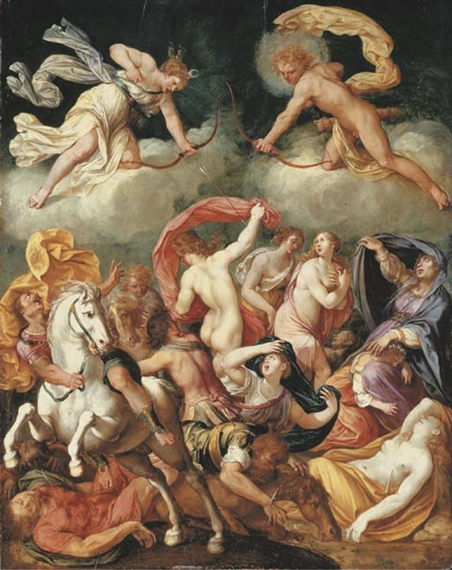Bernardino Cesari on:
[Wikipedia]
[Google]
[Amazon]
 Bernardino Cesari (1571 – 30 June 1622) was an Italian painter of the late-
Bernardino Cesari (1571 – 30 June 1622) was an Italian painter of the late-
 Bernardino Cesari (1571 – 30 June 1622) was an Italian painter of the late-
Bernardino Cesari (1571 – 30 June 1622) was an Italian painter of the late-Mannerist
Mannerism, which may also be known as Late Renaissance, is a style in European art that emerged in the later years of the Italian High Renaissance around 1520, spreading by about 1530 and lasting until about the end of the 16th century in Ita ...
and early Baroque
The Baroque (, ; ) is a style of architecture, music, dance, painting, sculpture, poetry, and other arts that flourished in Europe from the early 17th century until the 1750s. In the territories of the Spanish and Portuguese empires including ...
period, active mainly in Rome
, established_title = Founded
, established_date = 753 BC
, founder = King Romulus ( legendary)
, image_map = Map of comune of Rome (metropolitan city of Capital Rome, region Lazio, Italy).svg
, map_caption ...
and Naples
Naples (; it, Napoli ; nap, Napule ), from grc, Νεάπολις, Neápolis, lit=new city. is the regional capital of Campania and the third-largest city of Italy, after Rome and Milan, with a population of 909,048 within the city's adm ...
, where he assisted his brother Giuseppe Cesari
Giuseppe Cesari (14 February 1568 – 3 July 1640) was an Italian Mannerist painter, also named Il Giuseppino and called ''Cavaliere d'Arpino'', because he was created ''Cavaliere di Cristo'' by his patron Pope Clement VIII. He was much patronize ...
(Cavaliere d'Arpino).
On 9 November 1592, he was sentenced to death, for consorting with bandits, and fled to Naples. On 13 May 1593, he was pardoned and returned to Rome. In 1616, he travelled with Giuseppe to Naples to assist in painting in the Certosa di San Martino
The (" Charterhouse of St. Martin") is a former monastery complex, now a museum, in Naples, southern Italy. Along with Castel Sant'Elmo that stands beside it, this is the most visible landmark of the city, perched atop the Vomero hill that comman ...
, then to Piedimonte di Alife to paint a large ''Last Judgement'' in the chapel of the fathers "predicatori". He travelled to Monte Cassino
Monte Cassino (today usually spelled Montecassino) is a rocky hill about southeast of Rome, in the Latin Valley, Italy, west of Cassino and at an elevation of . Site of the Roman town of Casinum, it is widely known for its abbey, the first ho ...
where he laboured with Giuseppe in the frescoes for the refectory and the stanza of San Benedict, then to Rome where he painted an oil canvas of ''Noli me tangere'', a fresco of ''Constantine the Great'', a ''St. Peter'', and three oil paintings for the church Santi Cosma e Damiano
The basilica of Santi Cosma e Damiano is a titular church in Rome, Italy. The lower portion of the building is accessible through the Roman Forum and incorporates original Roman buildings, but the entrance to the upper level is outside the For ...
.
Works
*''Destruction of Niobe's Children'' *''Hannibal's Defeat by Scipio Africanus'' *''Noli me tangere'' *''Persephone and Andromeda'' *''St. Peter'',Santi Cosma e Damiano
The basilica of Santi Cosma e Damiano is a titular church in Rome, Italy. The lower portion of the building is accessible through the Roman Forum and incorporates original Roman buildings, but the entrance to the upper level is outside the For ...
*''St. Cecilia''
*''Diana and Acteon''
*''Sts. Stephen and Agatha''
*A fresco of Constantine the Great
*Paintings at Certosa di San Martino
The (" Charterhouse of St. Martin") is a former monastery complex, now a museum, in Naples, southern Italy. Along with Castel Sant'Elmo that stands beside it, this is the most visible landmark of the city, perched atop the Vomero hill that comman ...
, Naples
References
Bibliography
His biography is collected in Giovanni Baglione's ''Vite''. p. 139. * * 1565 births 1621 deaths People from the Province of Frosinone 16th-century Italian painters Italian male painters 17th-century Italian painters Painters from Naples Italian Baroque painters Italian Mannerist painters {{Italy-painter-16thC-stub